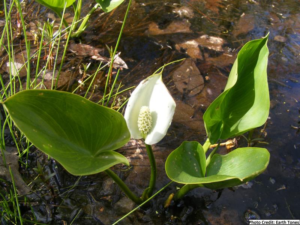by Kellsey Grange, summer intern
 Springtime in the marsh calls for a lot of activity. From leaves budding to flowering marsh marigolds, there is plenty of beauty in the marsh. If you dare to go mucking around a marsh or swale you will for sure stumble upon a flowering wild calla (Calla palustris). Also known a swamp lily or bog arum. Its genus name “Calla” is derived from the Greek word “kallos” meaning “beauty”. While its species name “palustustris” means “marsh loving” or “of marshes”.
Springtime in the marsh calls for a lot of activity. From leaves budding to flowering marsh marigolds, there is plenty of beauty in the marsh. If you dare to go mucking around a marsh or swale you will for sure stumble upon a flowering wild calla (Calla palustris). Also known a swamp lily or bog arum. Its genus name “Calla” is derived from the Greek word “kallos” meaning “beauty”. While its species name “palustustris” means “marsh loving” or “of marshes”.
This aquatic perennial is native to Alaska, Canada, and northern subarctic regions of the United States, Europe, and Asia. Wild calla prefers acidic humerus-rich soil found in bogs, rivers, ponds, and lakes. Wild calla can be 5-12 inches high with jointed stalks and heart-shaped leaves. When in flower the wild calla has a white oval-shaped flower wrapped around the spike (spadix, yellow-green). After flowering, green pear-shaped fruits develop on the spadix, which ripens to bright red in late summer.
The foliage of the plant is toxic and irritates the gastrointestinal tract of humans and animals.
This is due to the plant containing calcium oxalate crystals that can cause severe pain in the
mouth, tongue, and throat. Potentially leading to difficulty in speaking. These crystals are found
in the lily family (Arum). Including the wild callas relative the jack-in-the-pulpit (Arisaema
triphyllum), which is rumored to feel like eating glass when chewing.
However, historically indigenous peoples found multiple ways to utilize this marsh flower. If dried
the rhizome of wild calla can be ground up into flour in dire circumstances. The rhizome must be
fully cooked to destroy the calcium oxalate crystals, resulting in a starch-rich powder that can be
used to make bread (which has been said to be very tasty). Tea can also be made from a dried
wild calla root to treat the flu, shortness of breath, and bleeding, and as a poultice on swellings
and snakebites. The aerial stems have also been used in the treatment of sore legs.
So, if you ever feel so inclined to go off the beaten path and create your own in a swale; check
out the wild calla and its abundance in such a prime habitat.
Photo credit: Earth Tones
